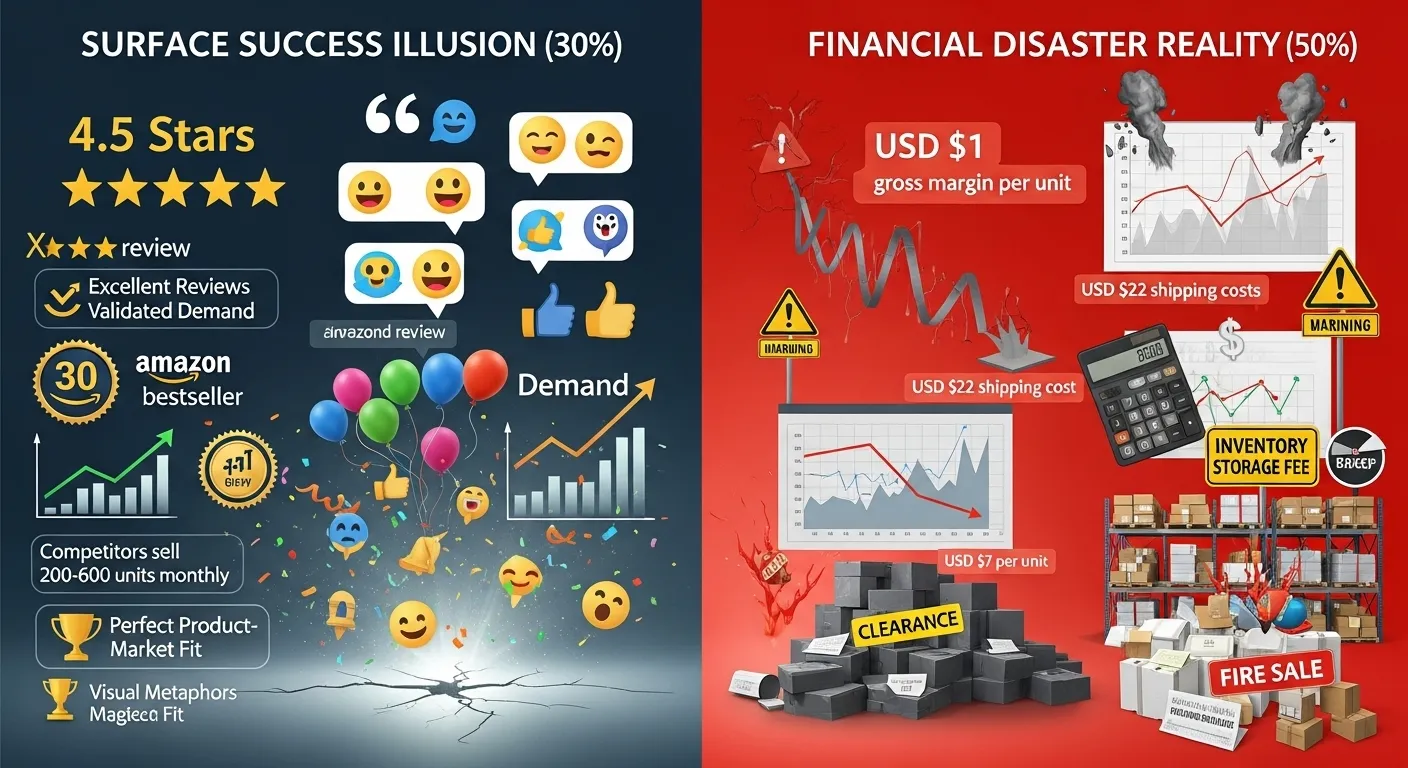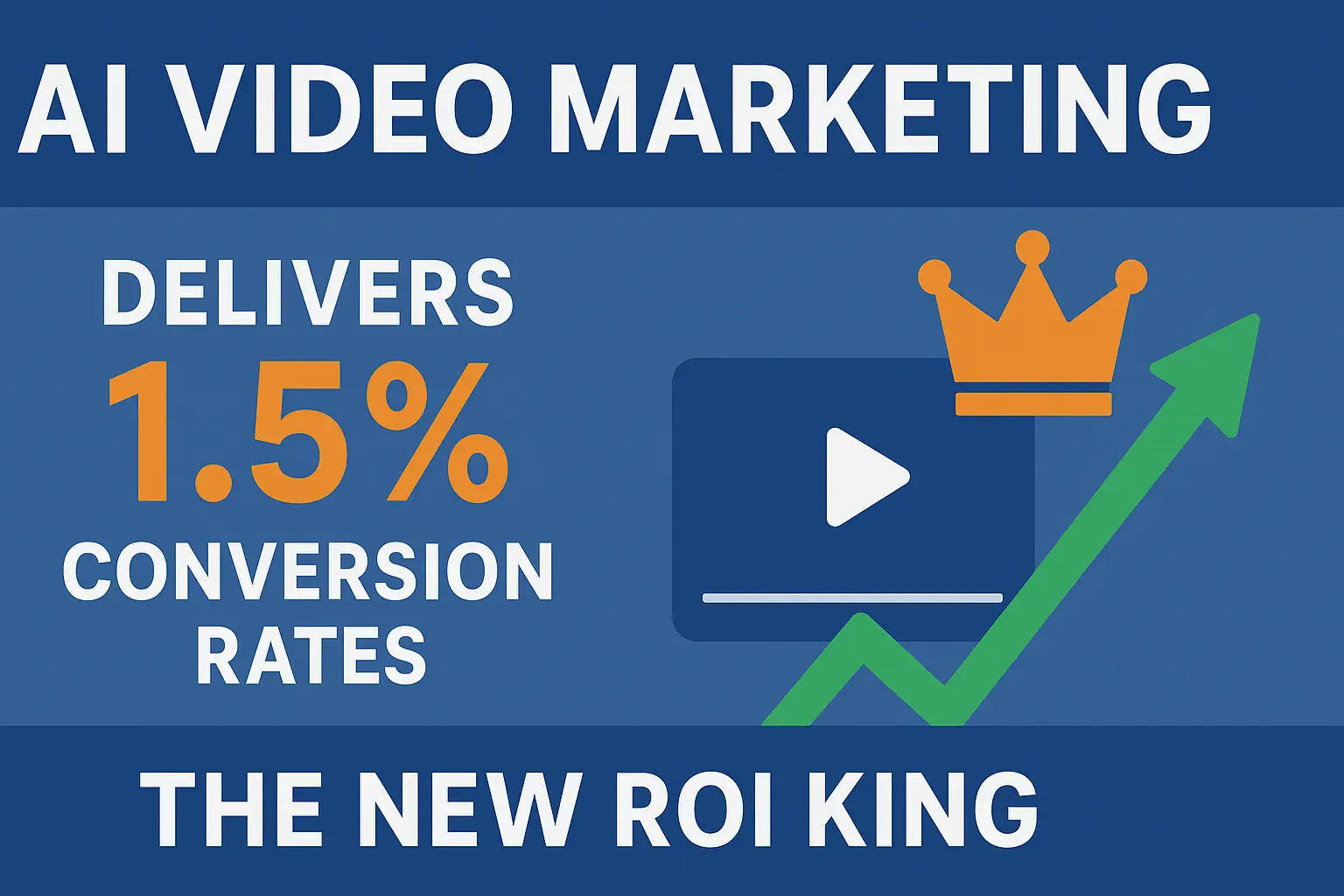Why 4.5-Star Amazon Products Can Still Destroy Your Business
What happens when you have everything an ecommerce seller dreams of—4.5-star reviews, validated demand, competitors selling hundreds of units monthly—yet your business still crashes and burns? A recent discussion on r/ecommerce revealed a sobering case study that every marketplace seller needs to understand: how excellent customer satisfaction means absolutely nothing if your margin architecture is fundamentally broken.
The seller launched piñatas on Amazon FBA in 2022, quickly earning 30 five-star reviews in two weeks through Amazon’s Vine program. Customers praised the quality, with negative reviews complaining the products were “impossible to break”—exactly what you’d want for a piñata business. Market research showed competitors successfully selling 200-600 units monthly. Everything looked perfect on paper.
Yet within months, the business collapsed completely. The inventory accumulated, storage fees mounted to $7 per unit, and the seller liquidated 70 packages for just $130—a devastating loss that highlights a critical truth about modern ecommerce: customer validation and product-market fit are meaningless without sustainable unit economics.
The Margin Architecture Disaster
The fundamental mistake wasn’t in product selection or customer research—it was in business model architecture. The seller decided to differentiate by selling two piñatas in a bundle, a decision that seemed logical for customer value but destroyed the economics entirely.
This bundling strategy triggered a cascade of operational disasters. The increased package size changed Amazon’s FBA fee structure dramatically, pushing shipping costs to $22 per unit. Combined with Amazon’s 15% commission and manufacturing costs, the gross margin collapsed to just $1 per unit before advertising expenses.
The Death Spiral Mathematics
With $1 gross margin per unit, every aspect of growth became impossible:
Customer Acquisition Paralysis: Amazon PPC campaigns require substantial advertising spend to gain visibility, but with $1 margins, even a single click could eliminate profitability entirely. The average cost-per-click in competitive categories often exceeds $1, making paid acquisition mathematically impossible.
Inventory Risk Amplification: Low margins provide no buffer for market fluctuations, seasonal changes, or competitive pricing pressure. Any disruption in sales velocity immediately creates cash flow problems and storage fee accumulation.
Scale Economics Inversion: Instead of achieving economies of scale through growth, larger inventory orders increased financial risk exponentially. More units meant more storage fees and greater potential losses during liquidation.
Market Position Vulnerability: Without advertising budget, the product couldn’t compete for visibility against sellers with healthier margins who could invest in PPC campaigns and promotional activities.
The Hidden Costs That Kill Ecommerce Businesses
Amazon FBA’s fee structure creates multiple cost layers that many sellers underestimate during initial planning. Understanding these hidden expenses is crucial for sustainable marketplace selling.
Storage Fee Escalation
Amazon’s long-term storage fees function as a profit-destruction mechanism for slow-moving inventory. At $6.90 per cubic foot for items stored over 365 days, products with poor velocity quickly become liabilities rather than assets. The piñata seller faced $7 per unit in storage fees—seven times their gross margin—creating a situation where unsold inventory actively destroyed business value.
Advertising Cost Requirements
Successful Amazon selling typically requires 15-30% of revenue invested in advertising to maintain visibility and competitive positioning. Products with thin margins cannot support this investment level, creating a competitive disadvantage that compounds over time. Sellers with healthy margins can outbid low-margin competitors, pushing them further down search results and reducing organic visibility.
Return and Damage Costs
Amazon’s customer-friendly return policy and FBA handling processes create additional cost pressures. Returned items often cannot be resold at full price, and damaged inventory becomes total loss. Low-margin products provide no buffer to absorb these inevitable costs, turning normal marketplace friction into business-threatening expenses.
Competitive Price Pressure
Marketplace dynamics create constant downward pressure on pricing through competitor actions, customer price sensitivity, and algorithmic optimization. Products with thin margins have no flexibility to respond to competitive pricing without entering loss territory, while competitors with better margins can engage in strategic price competition.
Why Product-Market Fit Isn’t Enough
The piñata case study demonstrates a fundamental misconception about ecommerce success: the belief that customer validation and market demand automatically translate to business viability. Modern marketplace selling requires a more sophisticated understanding of business model sustainability.
The Validation Trap
Traditional product validation focuses on customer interest, competitive analysis, and market size assessment. However, these metrics ignore the operational realities of marketplace selling, including fee structures, advertising requirements, and inventory management costs. A product can have perfect market fit while being commercially unviable due to structural economics.
Unit Economics vs. Market Opportunity
Large market opportunities can mask poor unit economics during initial analysis. The presence of successful competitors doesn’t guarantee that new entrants can achieve similar profitability, especially if those competitors entered the market under different conditions or have operational advantages that aren’t immediately apparent.
The Differentiation Paradox
Attempts at product differentiation often create unintended operational consequences. The piñata seller’s bundling strategy appeared customer-focused but fundamentally altered the cost structure in ways that made the business unsustainable. Differentiation strategies must be evaluated through operational and financial lenses, not just customer preference perspectives.
Strategic Framework for Margin Architecture Analysis
Successful ecommerce operations require systematic analysis of business model sustainability before product launch. This framework helps identify potential margin architecture problems during planning phases rather than after inventory investment.
The 40-40-20 Rule
Sustainable marketplace selling typically follows a 40-40-20 margin allocation: 40% for product cost and logistics, 40% for marketing and operational expenses, and 20% for profit and business development. Products that cannot support this allocation structure face significant sustainability challenges.
The piñata case violated this rule dramatically, with logistics costs alone consuming nearly half the selling price before considering product costs, marketing expenses, or profit requirements. This imbalance made sustainable operations impossible regardless of customer satisfaction or market demand.
Break-Even Analysis Beyond Basic Costs
Traditional break-even analysis often focuses only on direct costs while ignoring marketplace-specific expenses. Comprehensive analysis must include advertising requirements, storage fees, return costs, and competitive positioning investments. Products that appear profitable in basic analysis may be unsustainable when marketplace realities are included.
Scenario Planning for Operational Stress
Margin architecture must withstand operational stress including seasonal demand fluctuations, competitive pressure, supply chain disruptions, and marketplace policy changes. Products with thin margins have no flexibility to navigate these challenges, while those with robust margins can adapt to changing conditions.
The Customer Acquisition Cost Crisis
Modern ecommerce faces an endemic problem: rising customer acquisition costs that make many business models unsustainable. Amazon’s increasingly competitive environment exemplifies this challenge, where advertising costs continue climbing while conversion rates remain static or decline.
The Advertising Arms Race
Successful Amazon selling requires continuous investment in PPC campaigns to maintain visibility. As more sellers compete for the same keywords, advertising costs increase while effectiveness decreases. Products with healthy margins can participate in this arms race, while those with thin margins get priced out of competitive visibility.
Organic Visibility Decline
Amazon’s algorithm increasingly favors products with strong advertising performance, creating a cycle where paid visibility drives organic visibility. Sellers unable to invest in advertising see their organic rankings decline over time, further reducing sales velocity and margin sustainability.
The Profitability Threshold
Industry analysis suggests that Amazon products need gross margins exceeding 50% to sustain profitable operations with necessary advertising investment. Products with lower margins can achieve short-term success but struggle with long-term sustainability as competitive pressures intensify.
Alternative Business Model Approaches
The failure of traditional marketplace selling models has created opportunities for alternative approaches that address margin architecture challenges through operational innovation rather than just product selection.
Direct-to-Consumer Integration
Successful ecommerce operations increasingly combine marketplace selling with direct-to-consumer channels that offer better margin control and customer relationship management. This approach reduces dependence on platform-specific fee structures while building sustainable competitive advantages.
Value-Added Service Integration
Rather than competing solely on product features, innovative sellers are integrating services that justify premium pricing and improve customer lifetime value. These services can include personalized consultation, installation support, or ongoing customer success programs.
Technology-Enhanced Customer Experience
Advanced customer experience technologies can improve conversion rates and average order values while reducing customer acquisition costs. Interactive shopping experiences, personalized product recommendations, and real-time customer support create competitive advantages that support premium pricing strategies.
Modern conversational commerce platforms enable sellers to create differentiated customer experiences that justify higher margins while reducing dependence on paid advertising. By combining AI-powered personalization with human expertise, these platforms help overcome the fundamental challenges of marketplace selling.
The Future of Sustainable Ecommerce
The piñata seller’s experience represents a broader trend in ecommerce: the increasing difficulty of building sustainable businesses through traditional marketplace strategies. Rising costs, intensifying competition, and platform dependency create structural challenges that require new approaches to business model design.
Platform Diversification Strategies
Successful ecommerce operations increasingly diversify across multiple platforms and channels rather than depending on single marketplace success. This diversification reduces platform risk while providing multiple paths to profitability and customer acquisition.
Technology Integration for Competitive Advantage
Businesses that integrate advanced technologies for customer experience enhancement, inventory optimization, and marketing efficiency gain sustainable competitive advantages that support healthier margins and reduced customer acquisition costs.
Focus on Customer Lifetime Value
Rather than optimizing for individual transaction profitability, successful businesses focus on customer lifetime value through retention strategies, repeat purchase optimization, and relationship building that reduces overall acquisition costs.
Key Takeaways for Ecommerce Success
The piñata seller’s failure provides critical lessons for anyone considering marketplace selling or evaluating existing ecommerce operations:
Margin Architecture Comes First: Customer validation and market demand are meaningless without sustainable unit economics. Business model viability must be established before inventory investment, not discovered afterward.
Hidden Costs Are Real Costs: Marketplace selling involves numerous hidden expenses that many sellers underestimate. Comprehensive financial analysis must include all platform fees, advertising requirements, and operational costs.
Differentiation Must Consider Operations: Product differentiation strategies that ignore operational consequences often create more problems than they solve. Innovation must be evaluated through financial and operational lenses.
Technology Can Enable Better Models: Advanced customer experience technologies can help overcome traditional marketplace limitations by improving conversion rates, increasing average order values, and reducing customer acquisition costs.
The ecommerce landscape continues evolving toward models that prioritize sustainable profitability over growth at any cost. Businesses that understand and implement proper margin architecture while leveraging technology for competitive advantage will thrive, while those focused solely on traditional metrics will struggle with the same challenges that destroyed the piñata business.
Book Your Live Demo to discover how conversational commerce can help you build sustainable margin architecture while improving customer experience and reducing acquisition costs. Don’t let poor business model design destroy your product success.
Ready to avoid costly margin architecture mistakes? See how live shopping platforms can help you build sustainable ecommerce operations that support healthy margins and long-term profitability.



